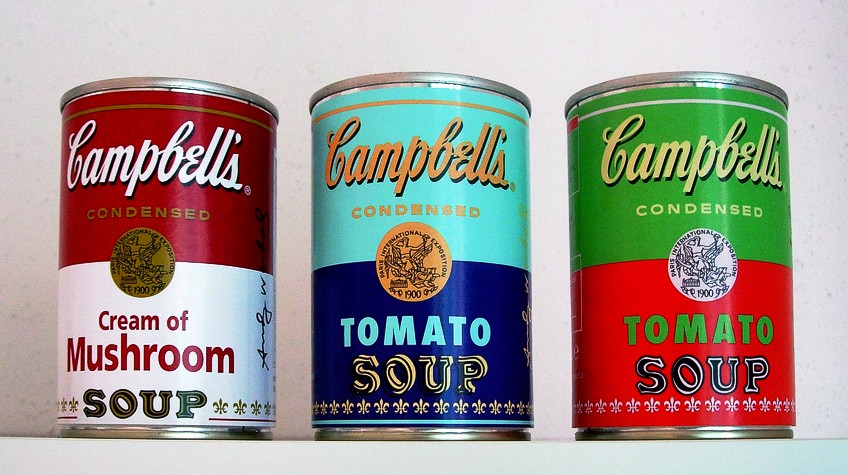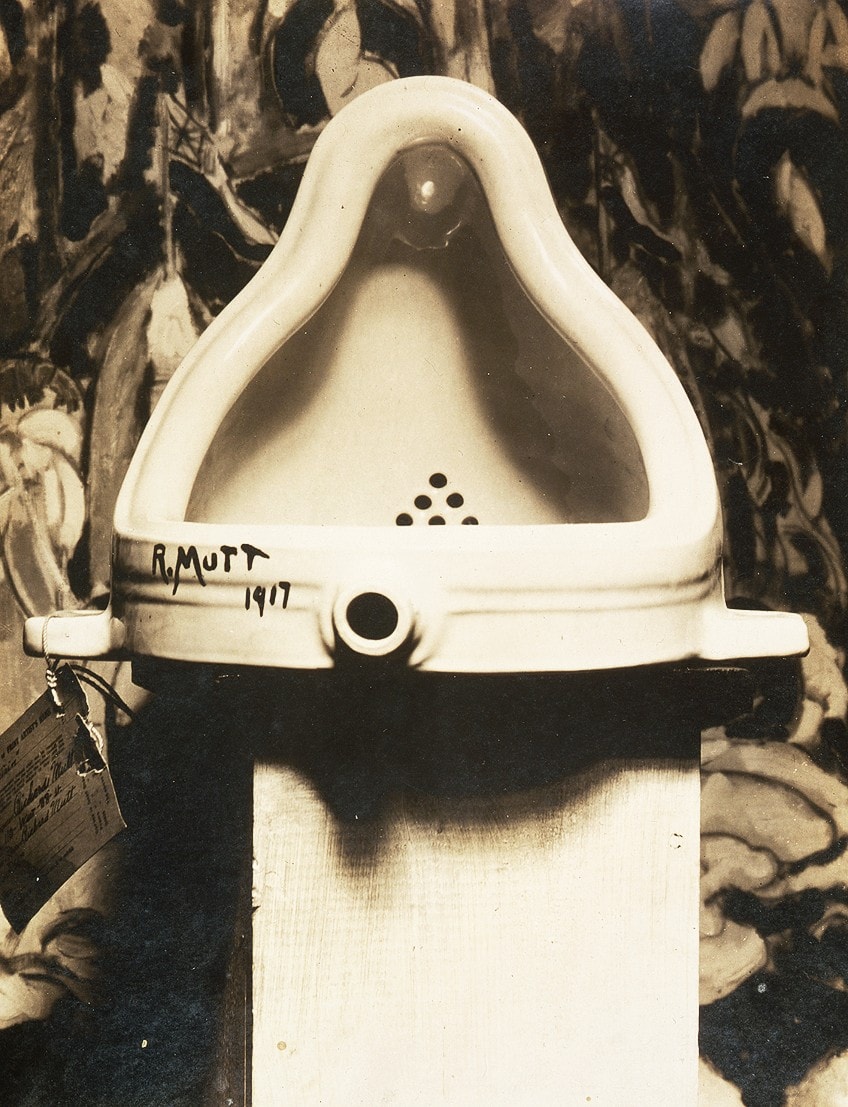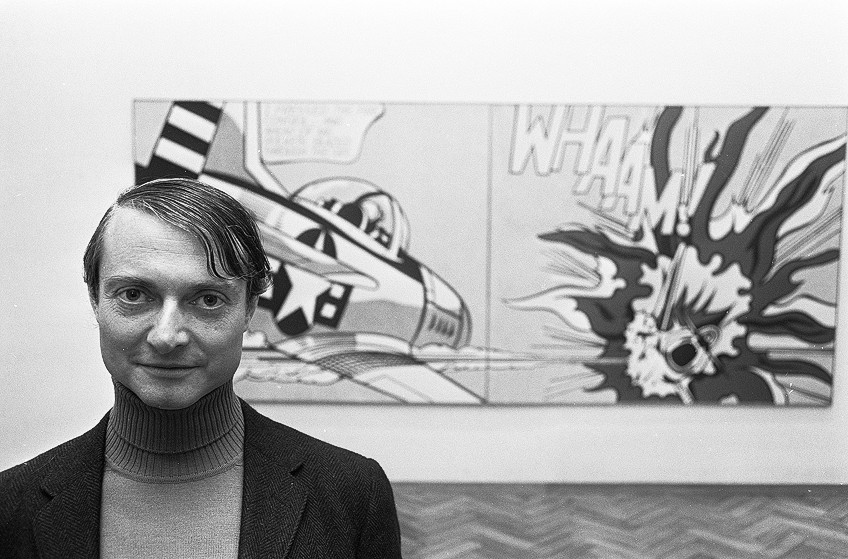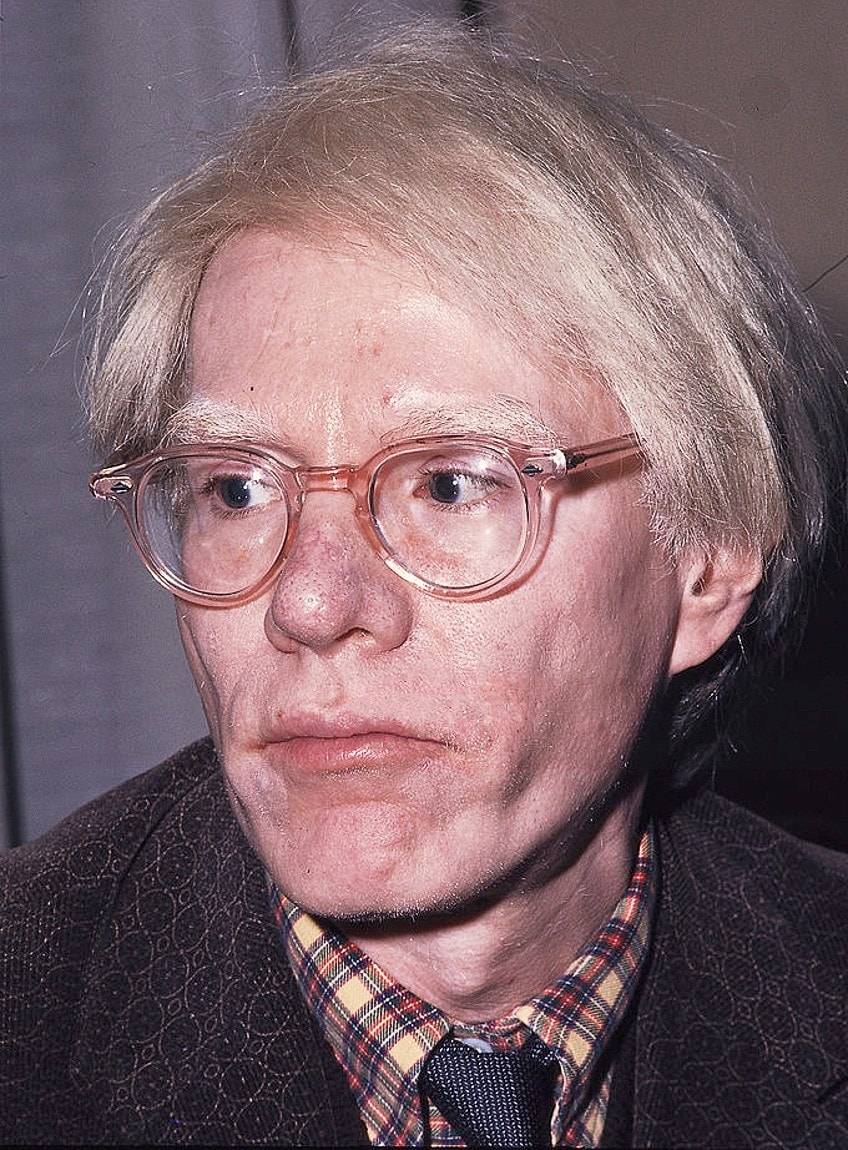Art Styles Of The 1960s
As members of the most influential cultural eras of the 20th century, 1960s artists were integral to the emergence of movements that reshaped and adult new artful languages and styles. As numerous criticisms of the educational arrangement grew, student demonstrations, the hippie motion, and 1960s art movements attempted to modify the world. Pop evolved to represent a new way of life battling against traditional high culture. In terms of visual fine art, 1960s art styles including Psychedelic art, Pop fine art, Minimalism, and Conceptual fine art emerged equally the nigh important and prototype-shifting ideas of the era.
Table of Contents
- ane 1960s Artwork
- i.1 The Rebellious Nature of 1960s Artists
- 1.2 Important 1960s Art Movements
- 2 Of import 1960s Artists
- ii.1 Roy Lichtenstein (1923 – 1997)
- two.two Andy Warhol (1928 – 1987)
- 2.3 Donald Judd (1928 – 1994)
- two.4 Sol LeWitt (1928 – 2007)
- ii.5 Peter Blake (1932 – Present)
- ii.6 Joseph Kosuth (1945 – Nowadays)
- 3 Ofttimes Asked Questions
- iii.i What Defined 1960s Fine art?
- 3.2 What Was a Popular 1960s Fine art Style?
1960s Artwork
The 1960s brought a new type of pop imagery and utilization of industrialized materials to art, mass-produced goods, consumerism, and the expanding bear on of American pop civilisation, its rock north' ringlet music, and burgeoning manufacture. Non only did the 1960s art movements encompass the new, but besides rebelled against the old status quo.
For many art historians, the rebellion of the 1960s is inextricably tied to the revolutionary ideas and deeds of avant-garde groups and their artists around the plow of the 20th century.
The Rebellious Nature of 1960s Artists
According to numerous points of view, the two periods share a feeling of disruption and a fertile imagination powered by technological exuberance. Above all, 1960s artwork and its main style Pop Fine art aspired to defection confronting the emotive drama and spirit of Abstract Expressionism.
Artists reinforced the concept of artistic expression past utilizing imagery from popular civilisation, despite the expressionistic move'south claim to represent high art.
 Campbell's Soup Cans(1962) by Andy Warhol, located at the Museum of Modern Art in New York City, U.s.a.; Gorup de Besanez, CC BY-SA four.0, via Wikimedia Commons
Campbell's Soup Cans(1962) by Andy Warhol, located at the Museum of Modern Art in New York City, U.s.a.; Gorup de Besanez, CC BY-SA four.0, via Wikimedia Commons
Several post-painterly brainchild painters, besides revolting against Abstract Expressionism artworks, erased the emotion by eliminating whatsoever testify of the artist's hand. The 1960s artists accentuated flat surfaces, vibrancy, and difficult-edge abstraction by removing the brushstrokes.
The growth of consumerist civilization and technology saw an increment in the utilization of commercial materials in the realm of art.
The Conceptual and Minimalist movements used mass-produced materials such as physical, brick, steel, and neon to produce sculptures and installation artworks that emphasized the thought and the technique to a higher place the outcome. This posed another challenge to the fine art world's institutions. The notion of the art object, its presence, and its identify were all redefined.
Important 1960s Art Movements
The following movements are regarded as pearls of 1960s artwork because they left nothing sacred and promoted living in a fashion that revolted against traditional notions. They altered the concept of the object, and materials, and developed the word ephemeral, which is intimately related to the developing Happening and Performance art movement.
Pop art is inextricably linked to the story of 1960s art styles, so we volition start in that location.
Pop Art
The movement is regarded as the about crucial period defining contemporary art considering of its breakthroughs. Pop fine art artists transformed the appearance of the painting by bringing a new type of corporate artful by using imagery from popular media and plant things. These concepts influenced not just visual art but besides graphic design, clothing, and a specific way of living.
Andy Warhol's conventionalities that "in the long term, everyone will one day be world-famous for xv minutes" affected the celebrity status of numerous artists and their crew in the 1960s arts community.
 Special edition of multicolored Campbell's Soup cans past Andy Warhol;Foto: Jonn Leffmann, CC BY 3.0, via Wikimedia Eatables
Special edition of multicolored Campbell's Soup cans past Andy Warhol;Foto: Jonn Leffmann, CC BY 3.0, via Wikimedia Eatables
Op Art
The Op art movement is founded on a response to the essential ingredient of creative production, namely visual perception. Op art artists of the 1960s fine art scene impacted the creation of Kinetic fine art and the expanding scene of Optical Illusion art by integrating abstruse and geometric fine art and experimenting with the most key of the art's elements, such as line, color, and dissimilarity.
Bridget Riley is ane of the about influential painters of this era.
Minimalist Art
Minimalism was the first internationally significant art trend to sally in America. It created a new manner of looking at and enjoying the artworks by emphasizing purity and simplification of its works. The rejection of the artist'due south emotion, along with a desire to create products that did not resemble loftier fine art, gave rise to geometric creations.
Minimalist artists attempted to deconstruct traditional concepts of painting and sculpture.
 Untitled (1988 – 1991) by Donald Judd, located in theBilly Rose Fine art Garden at the Israel Museum, in Jerusalem, State of israel;Talmoryair, CC Past-SA 4.0, via Wikimedia Eatables
Untitled (1988 – 1991) by Donald Judd, located in theBilly Rose Fine art Garden at the Israel Museum, in Jerusalem, State of israel;Talmoryair, CC Past-SA 4.0, via Wikimedia Eatables
The employment of readymade industrial materials, repeating geometric patterns, and attention to the actual space used by the artwork dominated the work of its notable artists, including Carl Andre, Donald Judd, and Robert Morris.
Conceptual Art
The conceptual fine art movement prioritized the artwork's premise over all else. Diverse forms and movements in fine art are stated to fall within this description, including performance, happenings, and the concept of the ephemeral apparent in Land art.
Conceptual designers rejected the notions of the bonny, uncommon, and skillful equally measurements of art, citing the concept of the readymade proposed by the famed Dada artist Marcel Duchamp.
 Alfred Stieglitz's photograph ofFountain (1917) by Marcel Duchamp;Marcel Duchamp , Public domain, via Wikimedia Commons
Alfred Stieglitz's photograph ofFountain (1917) by Marcel Duchamp;Marcel Duchamp , Public domain, via Wikimedia Commons
Many alluded to the movement as the epoch of dematerialization of art since it reduced the artworks to an essential minimum. The importance of 1960s art was reinforced by the advent of key movements like the Black art movement and Feminist fine art in the 1970s. Because of its volatile political events, 1960s art styles are considered a transitional time between contemporary and modernistic artistic creation.
Important 1960s Artists
When we identify the time as the Pop catamenia, artists like Peter Blake, Joseph Kosuth, Andy Warhol, Donald Judd, Roy Lichtenstein, Sol LeWitt, and Robert Rauschenberg immediately spring to mind. We owe the concept of life and art fusing similar never before to these artists.
The most recognized pop art artworks were inspired by industrial screen-printing techniques, graphics from comic strips and advertisements, and legendary music and flick stars.
Roy Lichtenstein (1923 – 1997)
| Nationality | American |
| Appointment of Birth | 27 October 1923 |
| Date of Death | 29 September 1997 |
| Place of Birth | Manhattan, New York |
The iconic Popular Fine art motion shocked the world and left a lasting impression on 20th-century art, motivated by materialism and a society of mass manufacturing. It began in the mid-1950s in the United Kingdom and spread to the Us, influencing the course of fine art.
Roy Lichtenstein was amongst the get-go American Pop painters to attain global recognition.
Lichtenstein, sculptor, painter, and printer, is regarded as ane of the most prominent artists of the new daring genre, whose main purpose was to describe fine art nearer to the full general population and to challenge the barriers separating fine art and mainstream civilisation. Roy Lichtenstein relocated to New Jersey in 1960 to go an associate professor of fine art at Douglass College. During the aforementioned period, he created his kickoff pop paintings, which featured cartoon motifs and methods inspired past the aesthetic of commercial printing.
 Roy Lichtenstein in forepart of his exhibit at the Stedelijk Museum in Amsterdam, holland;Eric Koch, CC0, via Wikimedia Eatables
Roy Lichtenstein in forepart of his exhibit at the Stedelijk Museum in Amsterdam, holland;Eric Koch, CC0, via Wikimedia Eatables
In 1961, he created Look Mickey, his debut artwork gratis of expressionism, inspired by a picture from one of his children's Trivial Golden Book series. Look Mickey is significant for its sardonic sense of humour and artistic merit, every bit well as being the earliest instance of the designer's apply of oral communication balloons, comic images, and Ben-Twenty-four hours dots every bit a basis for an artwork. Art critics encounter the painting as groundbreaking every bit a continuation of Pop Art and every bit an artwork of contemporary art in general. In 1961, Lichenstein met Ivan Karp, an art dealer.
Karp chose to represent Lichtenstein after the artist showed him numerous works. In 1962, he had a solo testify of his piece of work at the Leo Castelli Gallery, which earned him critical praise and a reputation in the art world.
Some of Lichenstein's most famous works were inspired past popular cultures, such equally commercial pictures, military comics, and pin-upward portraiture, likewise equally archetype painting genres including landscapes, all the same lives, and interiors.
Andy Warhol (1928 – 1987)
| Nationality | American |
| Date of Birth | half-dozen August 1928 |
| Date of Death | 22 February 1987 |
| Place of Birth | Pittsburgh, Pennsylvania |
It was the start of the 1950s when the art industry witnessed the birth of a new movement that would become on to become ane of the greatest of the 20th century. Popular Fine art, influenced by popular civilization images, simultaneously praised and condemned consumption decisions and mass replication, enjoying immense popularity throughout the post-obit 50 years and beyond.
Andy Warhol, an American artist, was a key figure in the creation of the new movement.
He was a great mastermind of his time, generating some of the virtually famous pictures of the 20th century, redefining numerous concepts, and introducing new ones that quickly established new norms. His lifestyle and art, which historic consumerism and the society of mass manufacturing, continue to obsess creatives and aficionados globe over 30 years later on his passing.
 Portrait of the American artist Andy Warhol at his exhibition defended to Blackness transvestites in the United States, November 1975;Unknown (Mondadori Publishers) , Public domain, via Wikimedia Eatables
Portrait of the American artist Andy Warhol at his exhibition defended to Blackness transvestites in the United States, November 1975;Unknown (Mondadori Publishers) , Public domain, via Wikimedia Eatables
Warhol obtained global acceptance for his pictures of soda bottles, soup cans, dollar bills, and iconic paintings of celebrities such as Elvis Presley, Jimmy Carter, Mick Jagger, Prince, and Elizabeth Taylor, working in a variety of media including painting, hand drawing, printmaking, silk screening, sculpture, photography, moving-picture show, and music.
Andy took an express train to New York City shortly later graduating to seek a career in the arts. It was also at this period that he omitted the "a" from his surname and began his career every bit a corporate illustrator. In September 1949, he was assigned to write an article for Glamour magazine titled Success is a Job in New York.
He was also deputed by prominent style publications such equally "Faddy", "Glamour", "Tiffany & Co.", and "Harper's Boutique", which helped him get one of the nearly sought-after American artists of the 1950s.
Donald Judd (1928 – 1994)
| Nationality | American |
| Date of Birth | 3 June 1928 |
| Date of Death | 12 February 1994 |
| Place of Birth | Excelsior Springs, Missouri |
Donald Judd, a postwar artist from America, is synonymous with Minimalist fine art. Despite his astringent objections to the term'due south vagueness, the creative person is best-selling as one of the most influential minimalists in art history. He tackled his work to produce sculptures that acquired a direct tangible and concrete being, without making great philosophical remarks.
Judd succeeded in constructing a disciplined visual linguistic communication that sought distinct and unambiguous objects as its principal means of articulation by eschewing the traditional principles of pictorial sculpture.
Afterward a brief foray into painting, Judd switched to the medium of woodcut in the late 1940s. The linear features of his newly chosen medium drew his focus away from representations and toward brainchild. By the early 1960s, he had forsaken the two-dimensional image plane entirely and begun to focus on three-dimensional shapes, with materiality playing a crucial part. Judd's artwork is often referred to as literalist because of the creative person's appetite to construct objects that could stand on their own.
 Untitled (1991) by Donald Judd, made out of enameled aluminum. Located at the Museum of Modern Art in New York City, United States;© 2019 Judd Foundation/Artists Rights Society (ARS), New York. Photo: John Wronn, CC BY-SA 4.0, via Wikimedia Eatables
Untitled (1991) by Donald Judd, made out of enameled aluminum. Located at the Museum of Modern Art in New York City, United States;© 2019 Judd Foundation/Artists Rights Society (ARS), New York. Photo: John Wronn, CC BY-SA 4.0, via Wikimedia Eatables
The artist'due south sculptures stand on the floor, abandoning the cardinal aspects of classical sculpture (including their location on a plinth), compelling spectators to address them from the viewpoint of their corporeal being.
Judd employed procedures and techniques linked with the Bauhaus School to distinguish his works from those created by artists working under the principles of Abstract Expressionism, giving his creations an emotionless, almost industrial expect. Another distinguishing feature of his was the serialization of his works, a tactic that reflected the realities of the postwar time and the apace rising consumerism.
Judd's work was viewed as an endeavor toward the accessibility of art, with the sculptures existence accessible to a wider range of individuals due to the use of produced elements.
Sol LeWitt (1928 – 2007)
| Nationality | American |
| Date of Birth | nine September 1928 |
| Date of Death | 8 April 2007 |
| Place of Nascency | Hartford, Connecticut |
Sol LeWitt popularized conceptual art with his announcement that the idea is the nigh essential part of the artwork, as one of the master characters in the formation of the new aesthetic of the 1960s that was in opposition to Abstract Expressionism. He was instrumental in establishing Minimalism and Conceptual art in the postwar era.
LeWitt saw creativity as an intellectual and utilitarian endeavor, believing that the concept itself might establish the work of art, displacing the artist into the office of a producer of that idea.
If the only duty of an creative person is to create a piece of work, he can either delegate creation to others or opt to never create anything at all. Someone had left him a book with Eadweard Muybridge's serial photography, sequent studies of humans and animals in move, which would later on turn out to exist the most influential on his work. His works on canvas with thick layers of oil paint, as well as three-dimensional pieces built as Serial Project in the 2d half of the 1960s, or diverse sculptures constructed of white cubes, were influenced by Muybridge's series.
 Four Sided Pyramid by Sol LeWitt, located at the National Gallery of Fine art Sculpture Garden in Washington, D.C., Us;David from Washington, DC, CC BY 2.0, via Wikimedia Eatables
Four Sided Pyramid by Sol LeWitt, located at the National Gallery of Fine art Sculpture Garden in Washington, D.C., Us;David from Washington, DC, CC BY 2.0, via Wikimedia Eatables
His debut work, Wall Drawing #ane, was shown at the Paula Cooper Gallery in New York in 1968. It was a network of parallel lines in iv quadrants made with a black pencil on a white wall, similar to many others following this i. The wall designs' existence was divers as a drove of instructions that could be applied again. After completing the kickoff one past himself, LeWitt quickly assembled a team of administration to carry out his ideas. In this sense, his piece of work'southward concept transcended the art itself.
In the early 1960s, Sol LeWitt began to produce his three-dimensional works, dubbed the structures, past focusing his investigation on the cube.
The reduced outlines of the open cube, constructed of wood and hand-lacquered, served as the foundation for the sculptures. Beginning in 1969, he built with industrial materials such every bit aluminum and steel, and subsequently, in the 1980s, he used concrete and cinder blocks.
Peter Blake (1932 – Nowadays)
| Nationality | English |
| Engagement of Birth | 25 June 1932 |
| Date of Decease | Northward/A |
| Identify of Nascence | Dartford, the United Kingdom |
While Andy Warhol is known equally the person who popularized fine art, many people regard Peter Blake to exist the move'southward founder. Aside from canvases, he is well-known for his involvement in imagery from mainstream culture, which he incorporates into his collages. Blake rose to prominence as 1 of the most well-known British pop performers in the late 1950s.
He created paintings that resembled collages. Images from existing literature, newspapers and ads, and concert hall entertainment are included in the creative person'due south career and works.
Blake oftentimes depicted wrestlers, and several of his works look like advertising or posters. Blake began painting collage-like portraits of singers and moving-picture show stars in 1959, every bit well as creating assemblages out of repurposed materials, postcards, and other artifacts. Along with his collages, Blake experimented with the art of imitation, creating painted collages, mimicked pin-upwardly panels and cubicle doors, expanded, repainted postcard themes, and produced affiche reproductions. He was originally associated with the nascent British Pop Art mode at the 1961 Young Contemporaries show.
On the Balcony (1957) is a key early work that has go an iconic work of British Popular Art, demonstrating Blake's involvement in blending popular culture motifs with fine art. The painting, which looks to be a collage but is entirely painted, depicts a youngster on the left of the organization clutching Édouard Manet's The Balcony (1868), insignia, and periodicals, amid other things. It was inspired past Honoré Sharrer'south picture Laborers and Paintings, which depicted workers clutching dandy paintings. Blake created various record covers.
In 1967, he created the Beatles' artwork for the anthology "Sergeant Pepper'south Lone Hearts Lodge Band". It became an iconic piece of popular art, widely replicated, and Blake'southward most well-known artwork.
Joseph Kosuth (1945 – Present)
| Nationality | American |
| Date of Nativity | 31 Jan 1945 |
| Date of Death | Northward/A |
| Place of Birth | Toledo, Ohio |
Joseph Kosuth was i of the pioneers of Conceptual art in the 1960s, supporting the premise that art should be free of all evidence of ability and adroitness for ideas to be disclosed as direct, promptly, and simply equally possible. Concerned with the analogies between the optical and verbal, and motivated by the theories of advice of philosopher Ludwig Wittgenstein, Kosuth sought to understand the human relationship betwixt phrases and their meanings, too as their straight effect on the objects they represent.
His work oftentimes incorporates intriguing phrases from literature, psychology, philosophy, and history, allowing the audience to ponder topics such as impoverishment, racism, solitude, alienation, the purpose of life, and cocky-identity.
Until 1967, Kosuth pursued fine art at the School of Visual Arts. Kosuth chose to enquiry philosophy and anthropology at the New School for Social Research afterward questioning the value of pictures in transmitting concepts and notions and studying the use of language.
He began creating intricate pieces at the historic period of 20 to declare Conceptual art and its understanding of art as a central notion and pregnant. His 1 and Three (1965) series of installations provided a direct examination of his aspirations past assembling the things, images of those things, and an expanded copy of the lexicon description.
His initial, and nigh renowned, case from this serial asks, "What exactly makes a chair in our minds – the particular or the word?"
Equally a piece of work that emphasizes the relationship between language, image, and signifier, it challenges the spectator with the usage of words for describing or identifying objects, investigating how language plays a vital part in communicating significant and condign the spoken or written analogue for the item.
A wave of radicalism swept through the 1960s. The decade altered the social and political scene, and its consequences may still be felt today, from global student rallies seeking democratization to the countercultural move that transformed the state. By the mid-1960s, Greenberg, Pollock, and their contemporaries' viewpoints had become institutionalized and distanced from the periphery, which kept pushing the formalist objectives of art, both in its production and its critical influence on society. What was avant-garde in the Westward no longer required a paintbrush and canvases, but instead 1960s art movements rebelled against tradition past mixing mutual themes, symbols, and topics, as well as new forms of media, into the fine art traditions.
Take a look at our 60s Art webstory here!
Frequently Asked Questions
What Divers 1960s Fine art?
During the 1960s, literature, artwork, dancing, and performance went through an heady time of evolution and transformation. Pop art and occurrences, for example, introduced fresh public attending to creative expression. Traditional notions of fiction writing were challenged past literary artists.
What Was a Popular 1960s Fine art Style?
Considering of its innovations, the Pop art movement is recognized as the about pivotal time in defining modern fine art. Pop painters inverse the appearance of the painting past introducing a new sort of corporate aesthetic through the use of imagery from mass culture and institute objects. These ideas influenced not simply visual art but also graphic arts, clothes, and a way of life.
Art Styles Of The 1960s,
Source: https://artincontext.org/1960s-art/
Posted by: christensenevisold.blogspot.com


0 Response to "Art Styles Of The 1960s"
Post a Comment